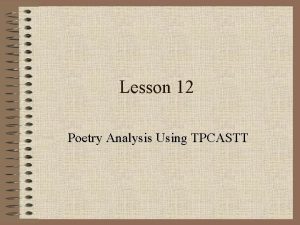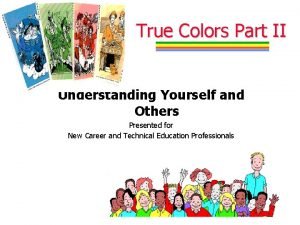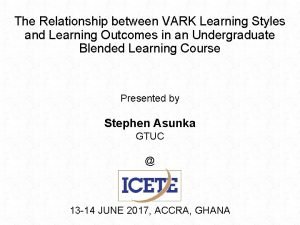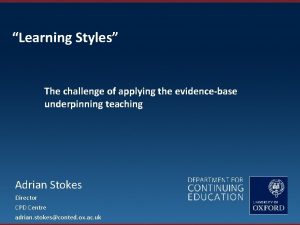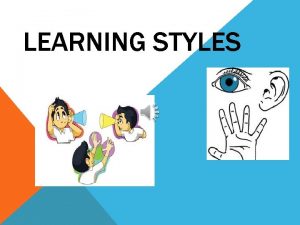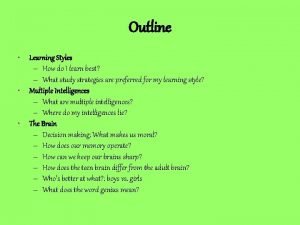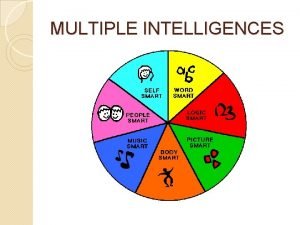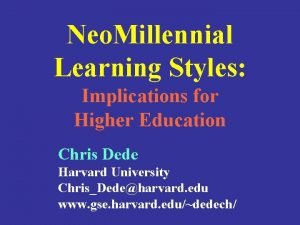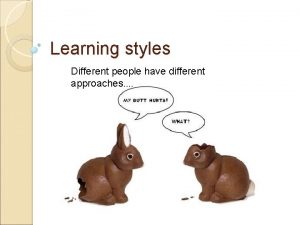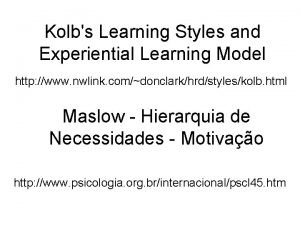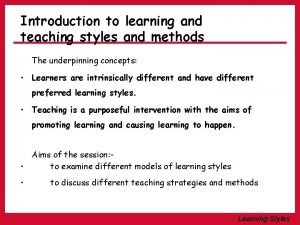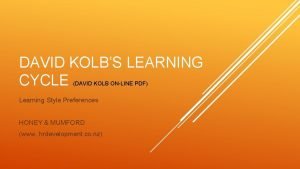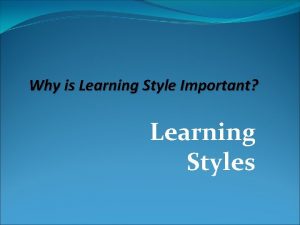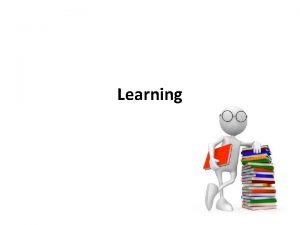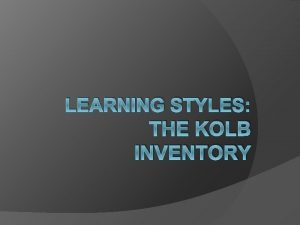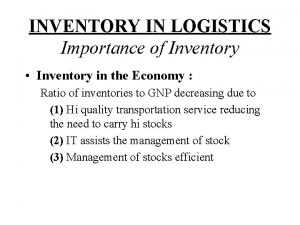Todays Agenda 1 Learning Styles Inventory 2 Learning

















- Slides: 17

Today’s Agenda 1. Learning Styles Inventory 2. Learning Pyramid 3. Learning Styles Notes 4. Teacher Talk # 9 5. Global vs. Analytic 6. “Learning Plan” 7. MASLOW October 15, 2015 Daily Objective: Students will be able to differentiate between Global and Analytical and explain its implication for learners. Homework: Finish Mr. /Mrs.

Learning Style Questionnaire and Multiple Intelligences Step One: Read statements 1 -36 on the LSQ. If the statement is true about YOU: Circle it. Step Two: Use the “Learning Style Grid” to record your scores. Place an X in the appropriate category for the items you circled. Step Three: Read through the Multiple Intelligences Inventory. Circle or highlight the statements that describe you. Complete the activity chart with your table mates.

What does the Learning Style Questionnaire reveal to you? Anything you didn’t already know? Why would it matter to a teacher? Specifically, how could he/she apply its findings in the classroom?

Learning Pyramid People Remember… Fill in the “What I think side of your learning pyramid using the terms below… 10% 20% 1. 2. 3. 4. 5. 30% hearing and seeing reading saying while doing something that reinforces what they say 6. seeing 50% 70% 90%

Ch ec ky ou ra ns w er s… Learning Pyramid People Remember… 10% 20% 30% of what they READ of what they HEAR of what they SEE 50% of what they HEAR & SEE 70% of what they SAY 90% of what they SAY WHILE DOING

Learning Styles Complete the Learning Styles note sheet based on the next seven slides.

Key Terms �Pedagogy is the art or science of being a teacher. � The term generally refers to strategies of instruction, or a style of instruction �Learning Styles (according to Dr. Dunn): biologically and developmentally imposed set of personal characteristics that make the same teaching method effective for some learners and ineffective for others.

Populations Stats Which style is favored? �Visual: �Auditory: �Kinesthetic/tactile: 46% 19% 35% *Most people like a mixture

Why Learning Styles? learn �Change the way you internally represent experiences, the way you recall information, and even the words �Your preferred styles guide the way you choose �Learning style uses different parts of the brain �By involving more of the brain during learning, we remember more of what we learn

Gardner’s Multiple Intelligences �Howard Gardner of Harvard has identified seven distinct intelligences. This theory has emerged from recent cognitive research and "documents the extent to which students possess different kinds of minds and therefore learn, remember, perform, and understand in different ways. ”

�Visual (spatial). You prefer using pictures, images, and spatial understanding. �Aural (auditory-musical). You prefer using sound and music. �Verbal (linguistic). You prefer using words, both in speech and writing. �Physical (kinesthetic). You prefer using your body, hands and sense of touch. �Logical (mathematical). You prefer using logic, reasoning and systems. �Social (interpersonal). You prefer to learn in groups or with other people. � Solitary (intrapersonal). You prefer to work alone and use self-study.

According to this theory. . . � We are all able to know the world through language, logical-mathematical analysis, spatial representation, musical thinking, the use of the body to solve problems or to make things, an understanding of other individuals, and an understanding of ourselves. � Where individuals differ is in the strength of these intelligences - the so-called profile of intelligences -and in the ways in which such intelligences are invoked and combined to carry out different tasks, solve diverse problems, and progress in various domains. "

Have you ever asked? Will you Why are we doing this? Should I use a pen or pencil? Doe s spel ling coun t? s i n e h W ? e u d s i th Do hav we e to this do ? check this before I turn it in? Will this be on the test?

Global vs. So… what do you think you are? ! Let’s do a quick “inventory” Analytical ~Read annotate “GLOBAL & ANALYTIC APPROACHES TO TEACHING” ~Complete the “POINTS TO PONDER” with your table mates ~Complete the “Clues…” sheet with your table mates. ~Complete the “Are you a left brain or right brain” inventory sheet individually. Column A Column B Left Brain: Right Brain: • Logical • Analytical • Verbal • Creativity • Imagination • Intuition

Global vs. Analytical 1. TEAM UP! Globals, go sit with globals. Analyticals, go sit with analyticals. Choose a recorder to record your answers to the following questions. 2. What do you like in school? Dislike? 3. How can teachers accommodate you in the classroom? Alternative assessments?

Global vs. Analytical 1. Now switch. Go PARTNER w/ your opposite. 2. Design a “lesson” that appeals to both global and analytical learners. 3. Fill out the “learning plan” document

 Todays agenda
Todays agenda Agenda sistemica y agenda institucional
Agenda sistemica y agenda institucional True colors gold
True colors gold Vark learning styles fleming 1987
Vark learning styles fleming 1987 Http://www.educationplanner.org/
Http://www.educationplanner.org/ Objectives of learning styles
Objectives of learning styles Learning styles outline
Learning styles outline Gardner learning styles
Gardner learning styles 7 learning styles
7 learning styles Millennial learning styles
Millennial learning styles Objectives of learning styles
Objectives of learning styles 7 learning styles and vark similarities
7 learning styles and vark similarities Kolbs learning styles
Kolbs learning styles Driver communication style examples
Driver communication style examples Why is knowing your learning style important
Why is knowing your learning style important Teaching styles
Teaching styles Kolb learning cycle pdf
Kolb learning cycle pdf Conclusion of learning styles
Conclusion of learning styles
